Nestled in the heart of the United States, Indiana boasts a diverse landscape that includes dense forests, expansive wetlands, rolling plains, and bustling urban areas.
Within this rich tapestry of ecosystems, one can discover a remarkable assembly of 22 distinct birds of prey. With their keen eyesight, powerful talons, and awe-inspiring hunting prowess, these raptors play a pivotal role in the state’s ecological balance.
From the iconic Bald Eagle gracing the skies over lakes and rivers to the secretive Eastern screech owl residing in suburban neighborhoods, each species contributes uniquely to Indiana’s avian diversity.
As apex predators, they capture our imagination and serve as indicators of environmental health. Join us on a journey to explore Indiana’s vibrant world of birds of prey.
22 Birds of Prey in Indiana
If you are interested in learning about the 22 birds of prey that can be found in Indiana, then you have come to the right place! This blog post will introduce you to these amazing raptors, their characteristics, habitats, diets, and calls. You will also find some tips on how to spot them and where to look for them in the Hoosier State.
1. Red-tailed Hawk (Buteo jamaicensis)
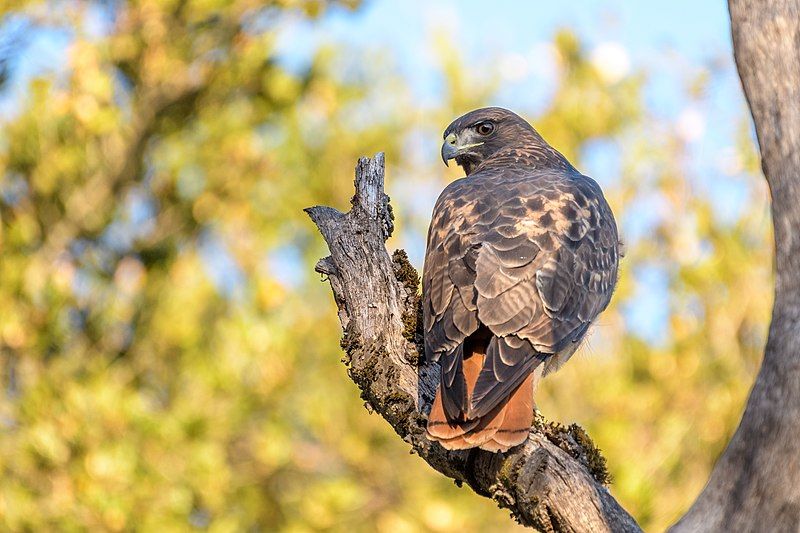
The Red-tailed Hawk, Buteo jamaicensis, is one of North America’s most iconic raptors. Its striking plumage features a rusty-red tail and a distinctive belly band. As a top predator, it occupies diverse habitats, from open fields to forests.
These hawks are known for their powerful soaring flight and keen eyesight, which aids in spotting prey like rodents, rabbits, and birds.
Often seen perched high on utility poles or in treetops, they are both a symbol of the wild and a common sight even in urban areas. Their haunting scream is a characteristic sound of North American skies, symbolizing freedom and the open landscape.
| Kingdom | Animalia |
| Phylum | Chordata |
| Clade | Dinosauria |
| Class | Aves |
| Order | Accipitriformes |
| Family | Accipitridae |
| Genus | Buteo |
| Species | B. jamaicensis |
2. Sharp-shinned hawk
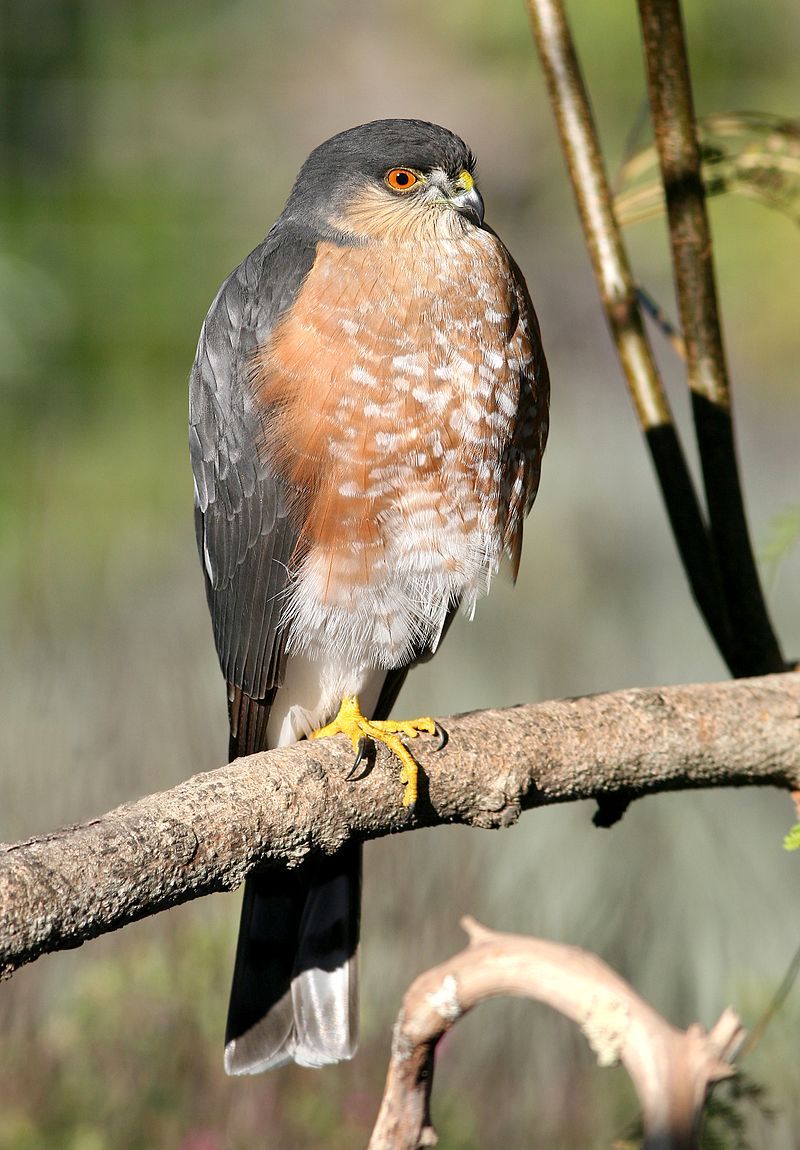
The Sharp-shinned Hawk, Accipiter striatus, is North America’s smallest hawk, known for its agility and sharp hunting skills. With short, rounded wings and a long tail, it expertly navigates dense forests.
Adults display blue-grey backs and distinctive orange-barred underparts. Sharp-shinned Hawks primarily prey on smaller birds, often surprising their quarry with sudden bursts of speed.
These raptors are frequent visitors to backyard bird feeders, seeking easy meals. They showcase breathtaking flight displays during migration, highlighting their grace and speed.
The presence of Sharp-shinned Hawks underscores the intricate dynamics of avian predation in woodland ecosystems.
| Kingdom | Animalia |
| Phylum | Chordata |
| Clade | Dinosauria |
| Class | Aves |
| Order | Accipitriformes |
| Family | Accipitridae |
| Genus | Accipiter |
| Species | A. striatus |
3. American Kestrel (Falco sparverius)

The American Kestrel, Falco sparverius, is North America’s smallest and most colorful falcon. It exhibits sexual dimorphism, with males featuring blue-grey wings and females having brown wings.
It is renowned for its hunting technique of hovering in mid-air before executing rapid dives to catch prey, including insects, small mammals, and birds. American Kestrels are commonly found in open habitats such as fields and meadows.
They nest in cavities, often using man-made structures. Their presence in urban areas aids in controlling rodent and insect populations.
Vibrant plumage, agile flight, and approachability make them a favorite among birdwatchers, symbolizing the delicate balance within ecosystems.
| Kingdom | Animalia |
| Phylum | Chordata |
| Clade | Dinosauria |
| Class | Aves |
| Order | Falconiformes |
| Family | Falconidae |
| Genus | Falco |
| Species | F. sparverius |
4. Cooper’s Hawk (Accipiter cooperii)
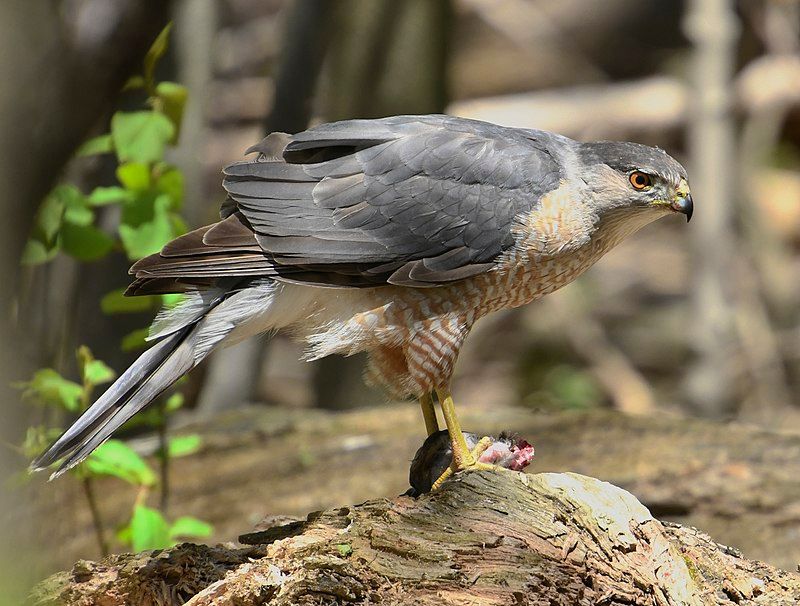
The Cooper’s Hawk, Accipiter cooperii, is a medium-sized hawk common in North American forests and woodlands. Known for their agility, they have short, rounded wings and a long tail, allowing them to navigate through dense trees.
They have blue-grey backs, reddish-barred chests, and dark caps. Cooper’s Hawks primarily prey on birds and small mammals and are often seen hunting near bird feeders in suburban areas.
Historically persecuted due to concerns about impacts on poultry and songbirds, they have adapted well to human-altered landscapes. Their presence in urban areas highlights the adaptability and resilience of wildlife in diverse habitats.
| Kingdom | Animalia |
| Phylum | Chordata |
| Clade | Dinosauria |
| Class | Aves |
| Order | Accipitriformes |
| Family | Accipitridae |
| Genus | Accipiter |
| Species | A. cooperii |
5. Broad-winged Hawk (Buteo platypterus)
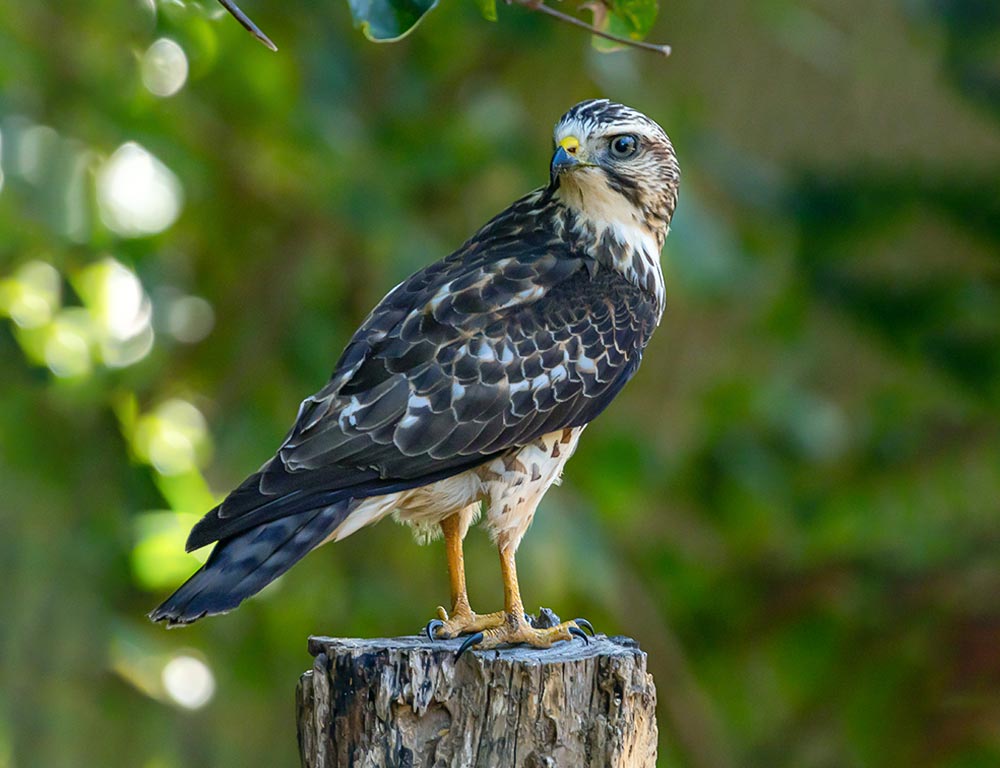
The Broad-winged Hawk, Buteo platypterus, is a small but social raptor known for its group migration behavior. It has brown plumage with white and brown bands on the tail.
These hawks primarily feed on small mammals and birds, hunting from forested perches and soaring on thermal currents.
During migration, they form large kettles, soaring together in spiraling thermals, a breathtaking spectacle. Broad-winged Hawks are known for their distinctive high-pitched call, which echoes through eastern forests during the breeding season.
Their group behavior and migration patterns make them a unique and remarkable species, exemplifying the interconnectedness of ecosystems across the continent.
| Kingdom | Animalia |
| Phylum | Chordata |
| Clade | Dinosauria |
| Class | Aves |
| Order | Accipitriformes |
| Family | Accipitridae |
| Genus | Buteo |
| Species | B. platypterus |
6. Red-shouldered Hawk (Buteo lineatus)
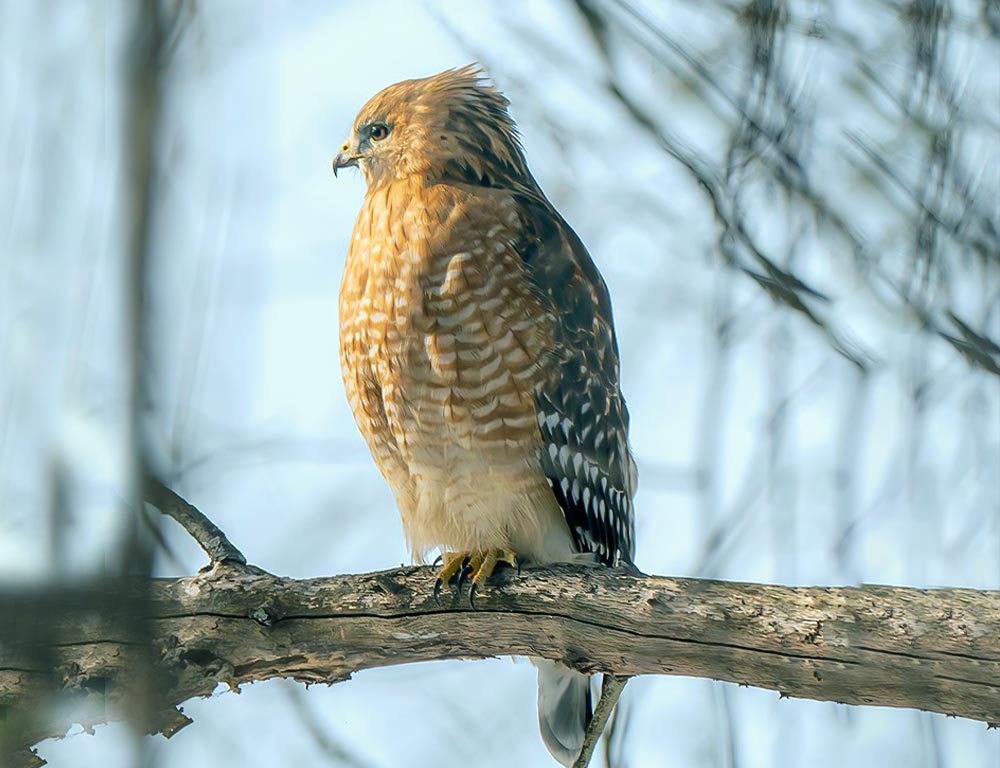
The Red-shouldered Hawk, Buteo lineatus, is a striking raptor found in North America. It is known for its distinctive plumage, with striking rust-red shoulders and a barred chest.
These hawks prefer wooded habitats near water sources, where they hunt for a diet consisting of small mammals, reptiles, and amphibians. Their haunting, high-pitched call is a characteristic sound of eastern forests.
Red-shouldered Hawks are diligent nest builders, often returning to the same territory each year. Their presence in wetland and woodland ecosystems signifies the health of these environments, making them an important indicator species.
These hawks are beautiful and vital for maintaining ecological balance in their habitats.
| Kingdom | Animalia |
| Phylum | Chordata |
| Clade | Dinosauria |
| Class | Aves |
| Order | Accipitriformes |
| Family | Accipitridae |
| Genus | Buteo |
| Species | B. lineatus |
7. Bald Eagle (Haliaeetus leucocephalus)
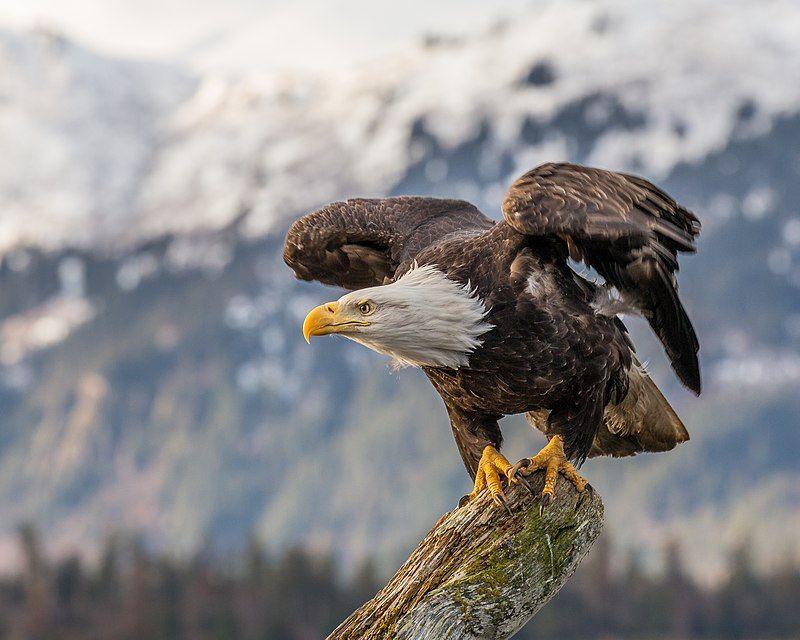
The Bald Eagle, Haliaeetus leucocephalus, is an iconic bird of prey and the national symbol of the United States. Recognizable by its striking white head and tail, it has a regal appearance. These eagles are primarily fish-eaters, often seen near lakes, rivers, and coasts.
They build enormous nests in large trees, cliffs, or even human-made structures. Bald Eagles have remarkably recovered from the brink of extinction due to DDT pollution, symbolizing the power of conservation efforts.
Their majestic presence and significant cultural importance highlight their status as a symbol of strength and freedom in both the natural world and human society.
| Kingdom | Animalia |
| Phylum | Chordata |
| Clade | Dinosauria |
| Class | Aves |
| Order | Accipitriformes |
| Family | Accipitridae |
| Genus | Haliaeetus |
| Species | H. leucocephalus |
8. Rough-legged Buzzard (Buteo lagopus)
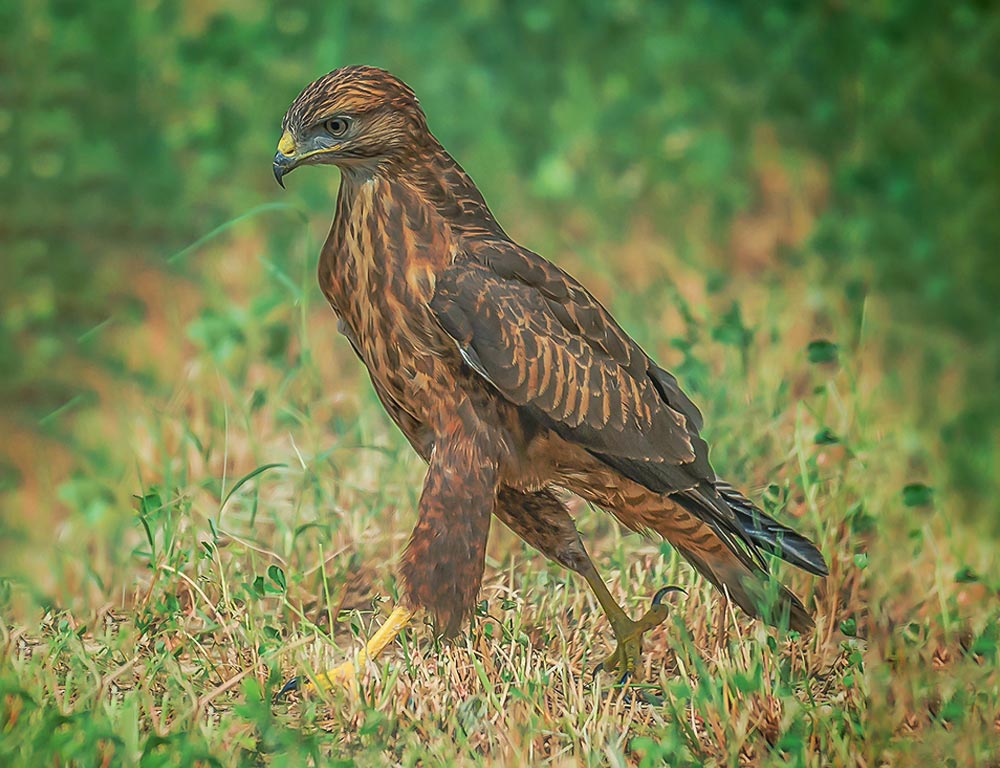
The Rough-legged Buzzard, Buteo lagopus, also known as the Rough-legged Hawk in North America, is a large raptor found in Arctic and boreal regions. Its distinctive feature is feathered legs down to the toes, an adaptation to cold environments.
The plumage varies but typically includes a brown back and a pale underside with dark streaks. It feeds primarily on small mammals like lemmings and voles and is known for hovering while hunting.
These buzzards migrate south to open fields and marshes during winter, showcasing their adaptability. Their resilience in harsh climates and graceful flight patterns make them a fascinating subject for birdwatchers and a symbol of the Arctic wilderness.
| Kingdom | Animalia |
| Phylum | Chordata |
| Clade | Dinosauria |
| Class | Aves |
| Order | Accipitriformes |
| Family | Accipitridae |
| Genus | Buteo |
| Species | B. lagopus |
9. Peregrine Falcon (Falco peregrinus)
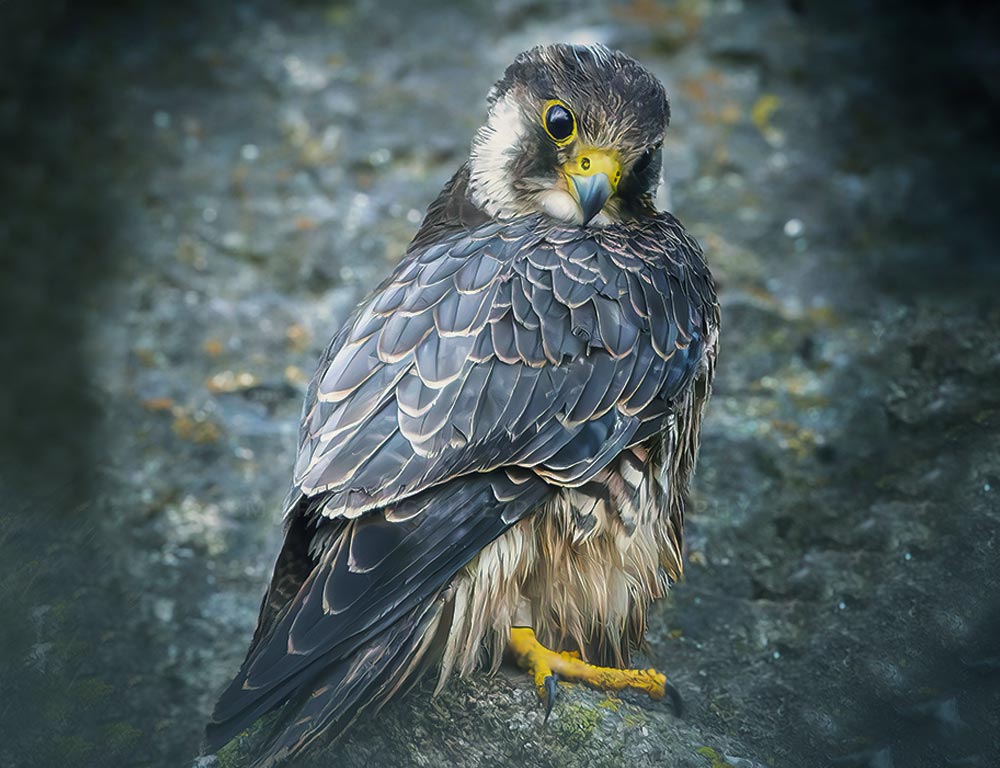
The Peregrine Falcon, Falco Peregrinus, holds the title of the fastest bird in the world, reaching speeds over 200 mph during its spectacular dives.
This cosmopolitan bird of prey is medium-sized with a blue-grey back, barred white underparts, and a distinctive black “moustache.”
Peregrines are known for hunting other birds in mid-air, displaying unmatched aerial skills. They often nest on cliffs, tall buildings, and other high structures.
Notably, they’ve made a remarkable recovery from the brink of extinction due to DDT exposure, serving as a symbol of successful conservation efforts.
Peregrine Falcons are admired for their speed, agility, and hunting prowess, symbolizing the power and precision of nature.
| Kingdom | Animalia |
| Phylum | Chordata |
| Clade | Dinosauria |
| Class | Aves |
| Order | Falconiformes |
| Family | Falconidae |
| Genus | Falco |
| Species | F. peregrinus |
10. Osprey (Pandion haliaetus)
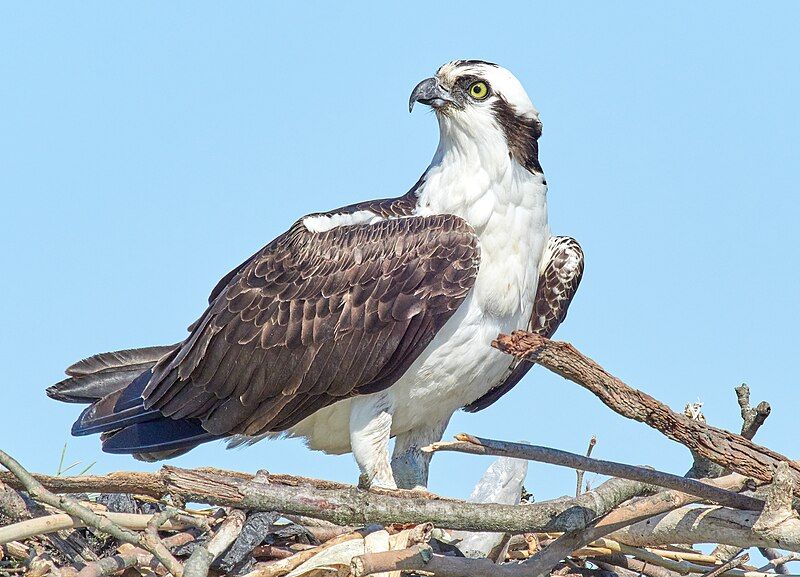
The Osprey Pandion haliaetus is a large raptor found near water bodies worldwide. Uniquely adapted for fishing, its primary food source, it has reversible outer toes and barbed pads on its feet to grip slippery fish.
Ospreys have a distinctive appearance with white underparts, dark brown upperparts, and a characteristic black stripe through the eye. They build large stick nests on structures like trees, cliffs, or man-made platforms.
The Osprey’s global distribution and specialized fish-eating habits make it a unique member of the raptor family, often considered a sentinel species for monitoring the health of aquatic environments.
Their striking presence near water bodies emphasizes the interconnectedness of ecosystems and the importance of preserving their habitats.
| Kingdom | Animalia |
| Phylum | Chordata |
| Clade | Dinosauria |
| Class | Aves |
| Order | Accipitriformes |
| Family | Pandionidae |
| Genus | Pandion |
| Species | P. haliaetus |
11. Swainson’s Hawk (Buteo swainsoni)

Swainson’s Hawk, Buteo swainsoni, is a striking raptor known for its long-distance migration, covering thousands of miles from North to South America.
With predominantly brown plumage and a distinctive dark bib, these hawks are adept hunters of insects, small mammals, and birds.
They can often be seen soaring on warm thermals or perched in open fields and prairies. Swainson’s Hawks are known for their highly social behavior during migration, forming large flocks known as “kettles.”
Their migratory journey is one of the most remarkable in the raptor world, highlighting the interconnectedness of ecosystems across continents.
| Kingdom | Animalia |
| Phylum | Chordata |
| Clade | Dinosauria |
| Class | Aves |
| Order | Accipitriformes |
| Family | Accipitridae |
| Genus | Buteo |
| Species | B. swainsoni |
12. Falcons and Caracaras (Family Falconidae)
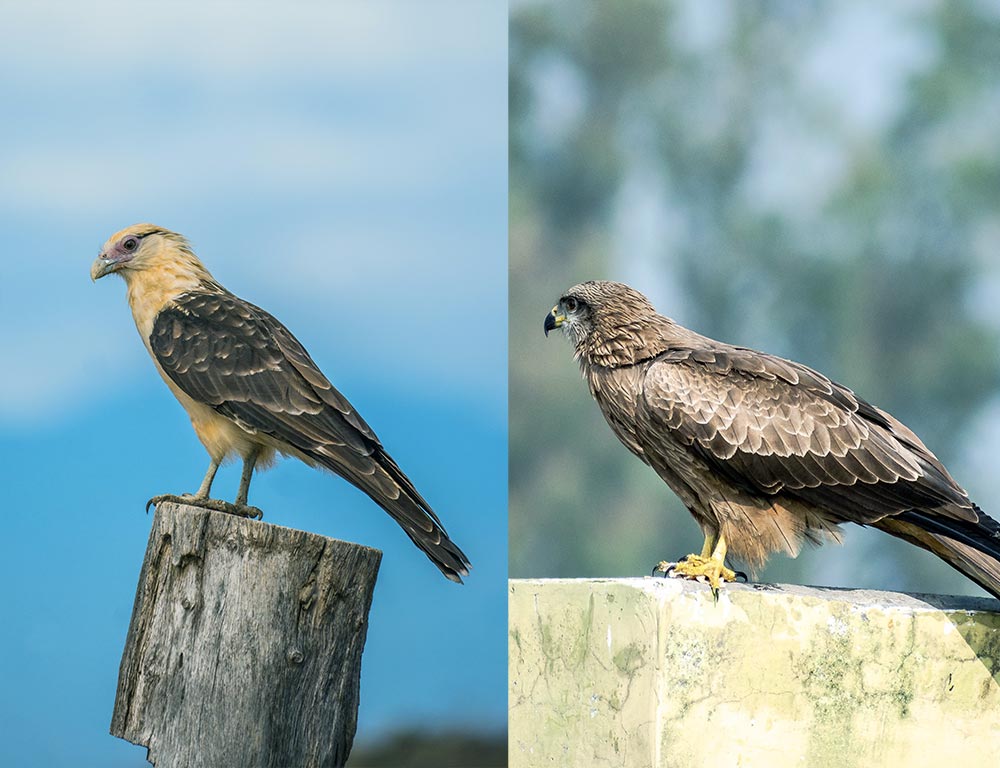
The family Falconidae encompasses various raptors, including Falcons and Caracaras. Falcons are known for their sleek bodies, sharp beaks, and incredible speed in flight.
They are agile hunters, preying on birds and small mammals. Caracaras, on the other hand, are larger and often have striking facial markings.
They are scavengers and opportunistic hunters, sometimes stealing food from other birds. Both Falcons and Caracaras are known for their strong talons and hooked beaks, which they use to capture prey.
They are distributed worldwide and play vital roles as top predators in various ecosystems.
| Kingdom | Animalia |
| Phylum | Chordata |
| Clade | Dinosauria |
| Class | Aves |
| Order | Falconiformes |
| Family | Falconidae |
13.Great Horned Owl (Bubo virginianus)
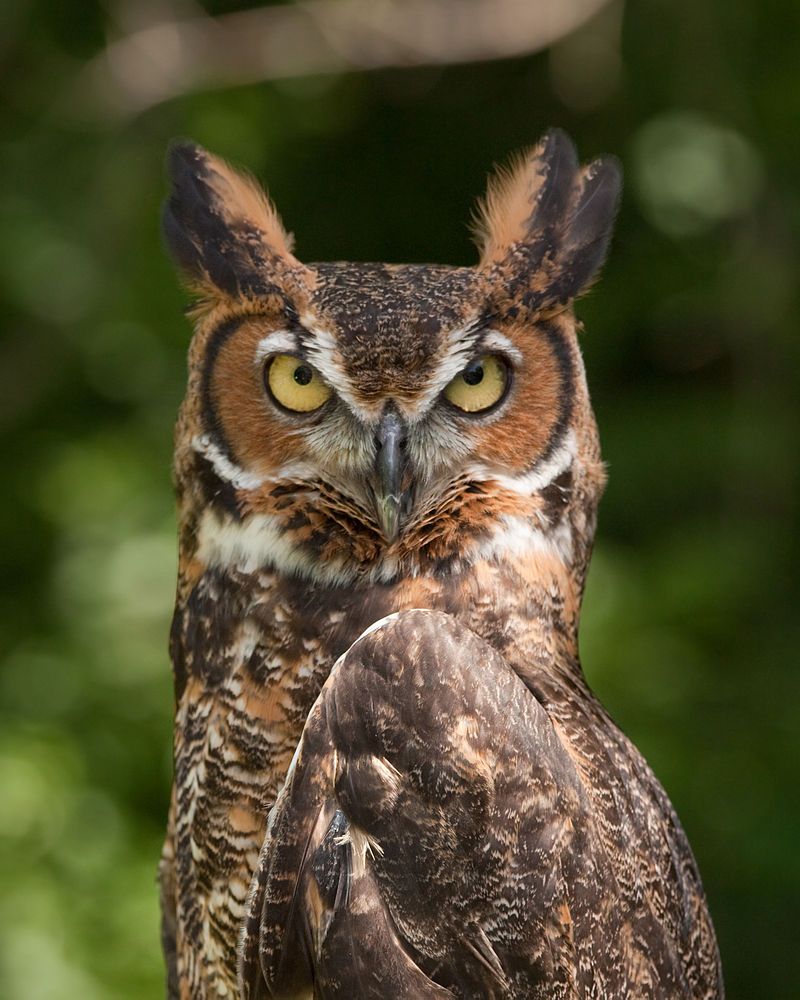
The Great Horned Owl, Bubo virginianus, is a powerful and adaptable owl species known for its distinctive “horns” or tufts of feathers on its head. These owls have large bodies with mottled brown plumage and striking yellow eyes.
They are highly skilled hunters, preying on various animals, from small mammals to birds. Great Horned Owls are often found in diverse habitats, including forests, deserts, and urban areas.
Their adaptability and silent flight make them formidable nocturnal predators. They are one of the largest owl species in North America and play a vital role in controlling rodent populations.
| Kingdom | Animalia |
| Phylum | Chordata |
| Clade | Dinosauria |
| Class | Aves |
| Order | Strigiformes |
| Family | Strigidae |
| Genus | Bubo |
| Species | B. virginianus |
14. Golden Eagle (Aquila chrysaetos)
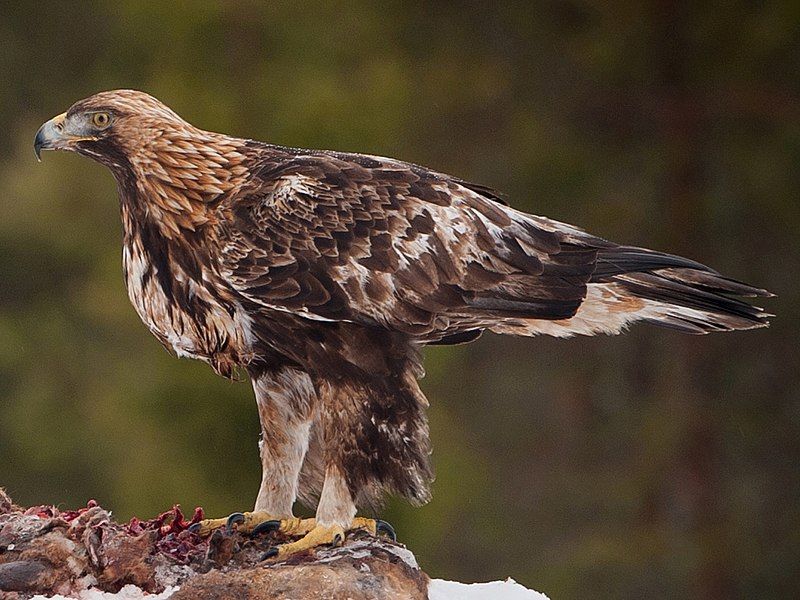
The Golden Eagle, Aquila Chrysaetos, is one of the most majestic raptors with its large size, golden-brown plumage, and powerful talons.
These eagles are apex predators, hunting various prey, including mammals, birds, and occasionally larger animals like deer fawns.
They are known for their keen eyesight and soaring flight. Golden Eagles are often found in open landscapes, including mountains, deserts, and grasslands.
They build large stick nests on cliffs or rocky outcrops. Revered by many cultures throughout history, Golden Eagles symbolize strength and freedom.
Their presence in ecosystems helps control prey populations and ensures the health of the environments they inhabit.
| Kingdom | Animalia |
| Phylum | Chordata |
| Clade | Dinosauria |
| Class | Aves |
| Order | Accipitriformes |
| Family | Accipitridae |
| Genus | Aquila |
| Species | A. chrysaetos |
15. Barn Owl (Tyto alba)
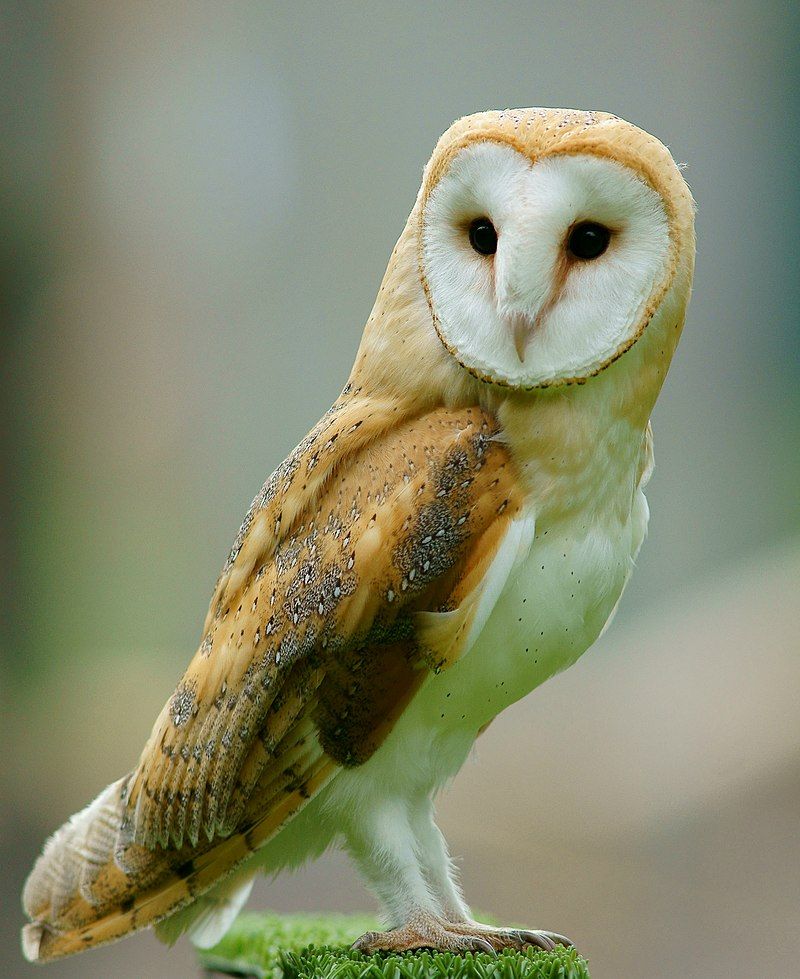
| Kingdom | Animalia |
| Phylum | Chordata |
| Clade | Dinosauria |
| Class | Aves |
| Order | Strigiformes |
| Family | Tytonidae |
| Genus | Tyto |
| Species | T. alba |
16. Barred Owl (Strix varia)

The Barred Owl, Strix varia, is a medium-sized owl species with striking barred plumage, a round face, and dark, soulful eyes. Known for its distinctive “who-cooks-for-you” call, they inhabit forests across North America.
Barred Owls are highly adaptable, often found near water sources where they prey on small mammals, birds, and amphibians. They are known for their silent flight, a hallmark of owl species, which aids in stealthy hunting at night.
Their adaptability to urban areas has made them a common sight, even in city parks. The Barred Owl symbolizes the enigmatic nature of nocturnal predators and their essential role in maintaining the balance of forest ecosystems.
| Kingdom | Animalia |
| Phylum | Chordata |
| Clade | Dinosauria |
| Class | Aves |
| Order | Strigiformes |
| Family | Strigidae |
| Genus | Strix |
| Species | S. varia |
17. Goshawk (Accipiter gentilis)
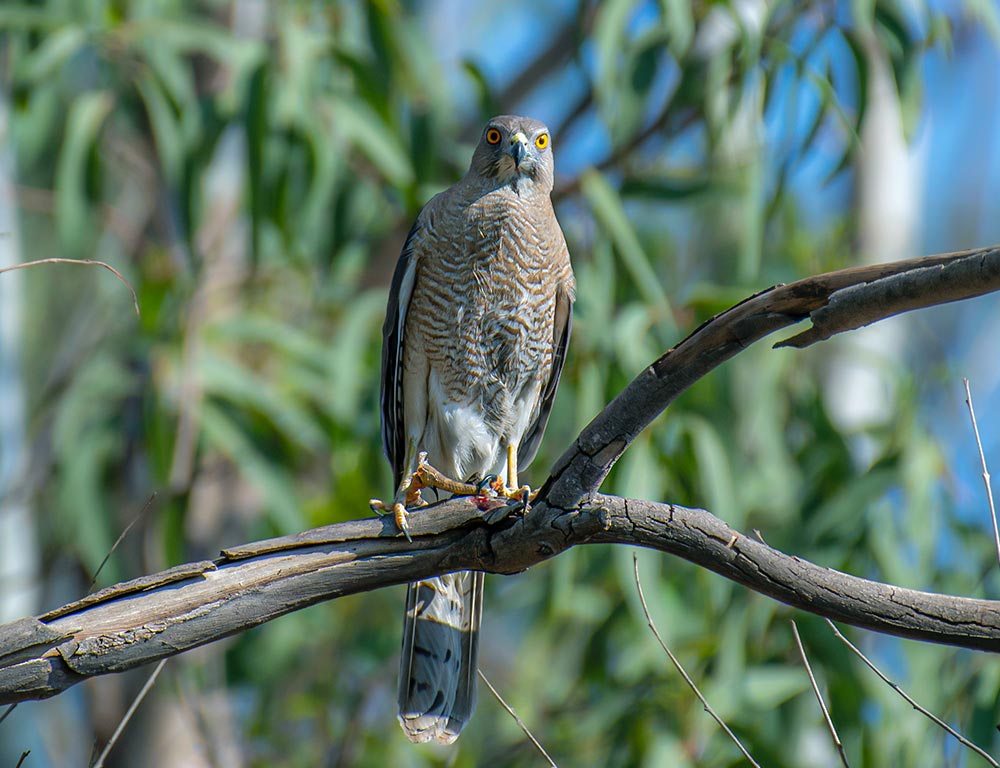
The Goshawk, Accipiter gentilis, is a formidable and powerful raptor known for its striking appearance and hunting prowess. With slate-grey plumage and piercing red eyes, they occupy forests across the Northern Hemisphere.
Goshawks are expert bird hunters, using their agility and speed to pursue prey through dense woods. They are known for their fierce defense of nests, and their presence in mature forests indicates ecosystem health.
Goshawks have a mystique surrounding them, often associated with the challenges of navigating the woodland realm.
| Kingdom | Animalia |
| Phylum | Chordata |
| Clade | Dinosauria |
| Class | Aves |
| Order | Accipitriformes |
| Family | Accipitridae |
| Genus | Accipiter |
| Species | A. gentilis |
18. Turkey Vulture (Cathartes aura)
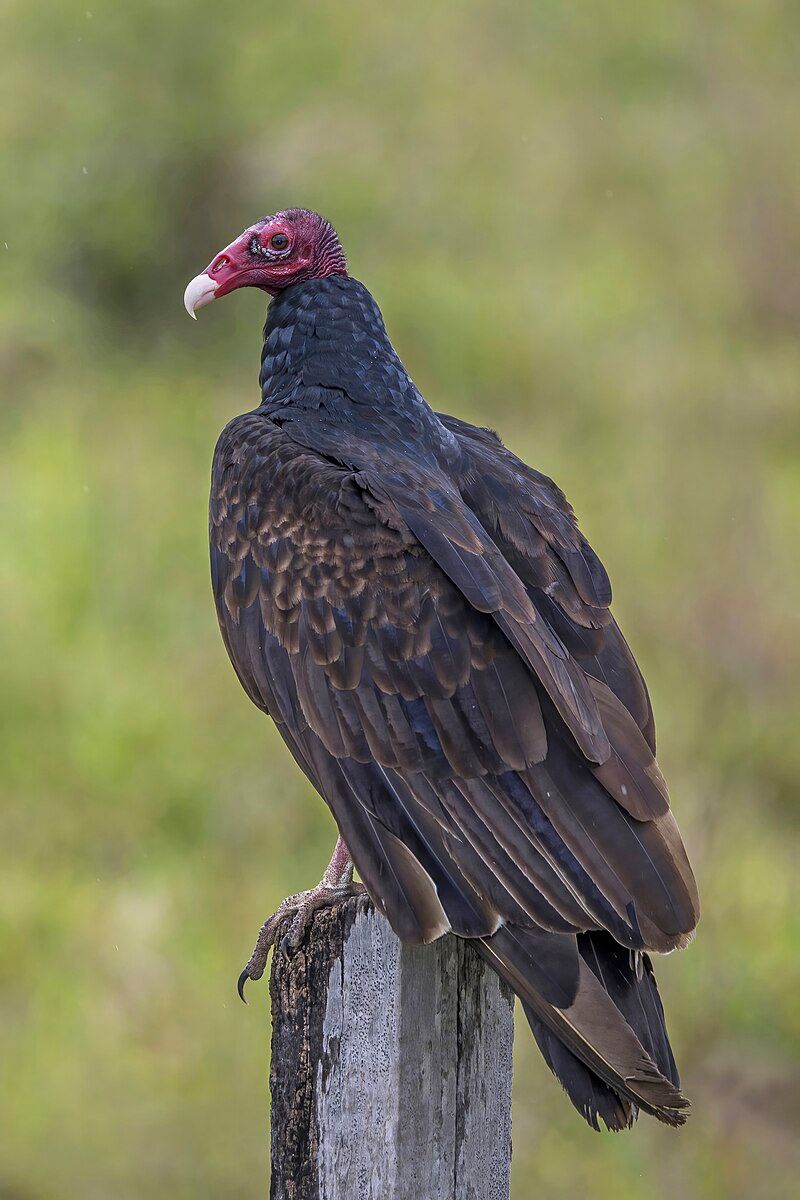
The Turkey Vulture, Cathartes aura, is a unique bird of prey recognized by its featherless red head and dark plumage. These scavengers have a remarkable sense of smell, aiding in the detection of carrion.
Often seen soaring in large groups, Turkey Vultures play a vital role in cleaning up carcasses and preventing the spread of disease.
They are gentle birds, and their ecological importance in recycling nutrients cannot be overstated. Turkey Vultures serve as nature’s cleanup crew, highlighting the ecosystem’s less glamorous but crucial aspects.
| Kingdom | Animalia |
| Phylum | Chordata |
| Clade | Dinosauria |
| Class | Aves |
| Order | Accipitriformes |
| Family | Cathartidae |
| Genus | Cathartes |
| Species | C. aura |
19. Ferruginous Hawk (Buteo regalis)

The Ferruginous Hawk, Buteo regalis, is a large, regal raptor found in North America’s open landscapes. Named for its rusty-colored plumage, they are the largest of the Buteo hawks.
Ferruginous Hawks primarily feed on small mammals, especially ground squirrels and prairie dogs. They are often seen perched on fence posts or utility poles while scanning for prey.
Their presence in grasslands and prairies signifies the health of these ecosystems. Ferruginous Hawks are known for their conservation status, as they face habitat loss and persecution.
Their majestic appearance and role as top predators make them an emblem of the open spaces they call home.
| Kingdom | Animalia |
| Phylum | Chordata |
| Clade | Dinosauria |
| Class | Aves |
| Order | Accipitriformes |
| Family | Accipitridae |
| Genus | Buteo |
| Species | B. regalis |
20. True Owl (Family Strigidae)
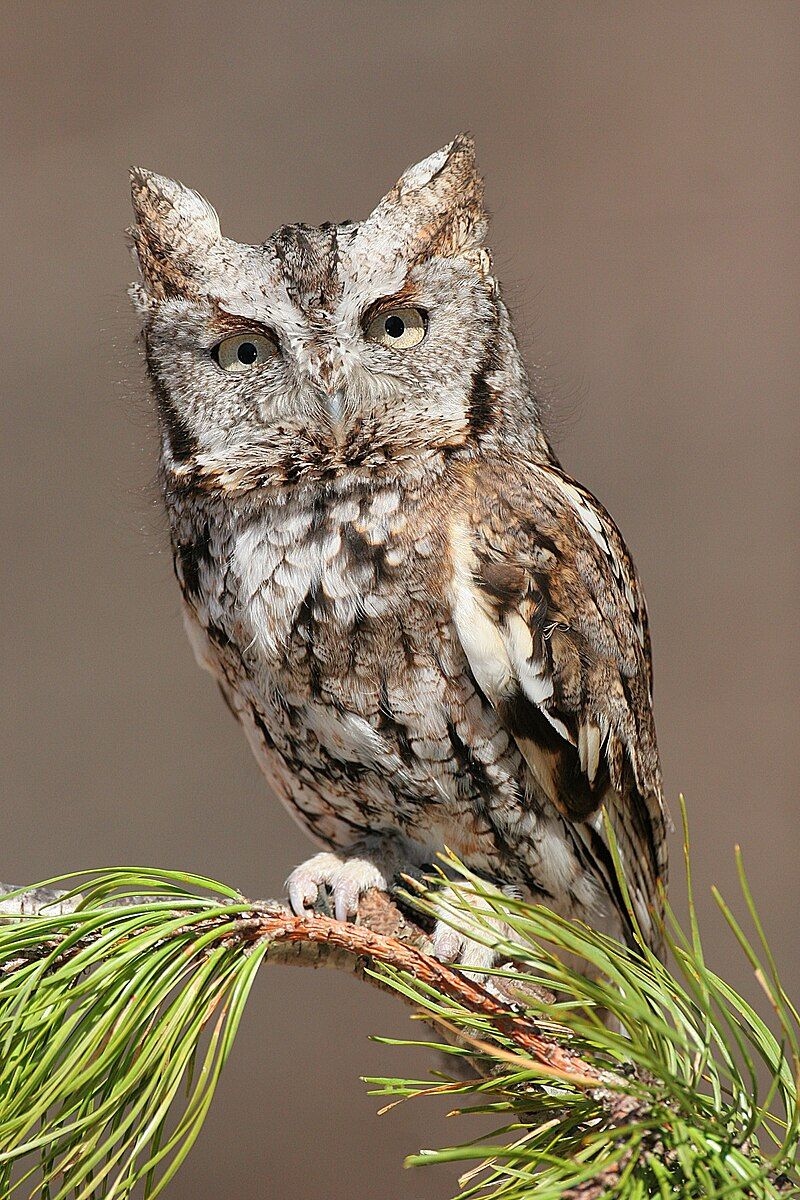
True Owls, belonging to the family Strigidae, encompass a diverse group of owl species found worldwide. Known for their large, forward-facing eyes, flat faces, and silent flight, they are skilled nocturnal hunters.
True Owls come in various sizes and plumage patterns, adapted to their specific habitats and prey. They are vital for controlling rodent populations and play significant roles in ecosystems.
Their enigmatic presence in the night has captured human fascination for centuries, often symbolizing wisdom or mystery. True Owls, with their remarkable adaptations, embody the nocturnal world’s wonders.
| Kingdom | Animalia |
| Phylum | Chordata |
| Clade | Dinosauria |
| Class | Aves |
| Order | Strigiformes |
| Family | Strigidae |
21. Short-eared Owl (Asio flammeus)
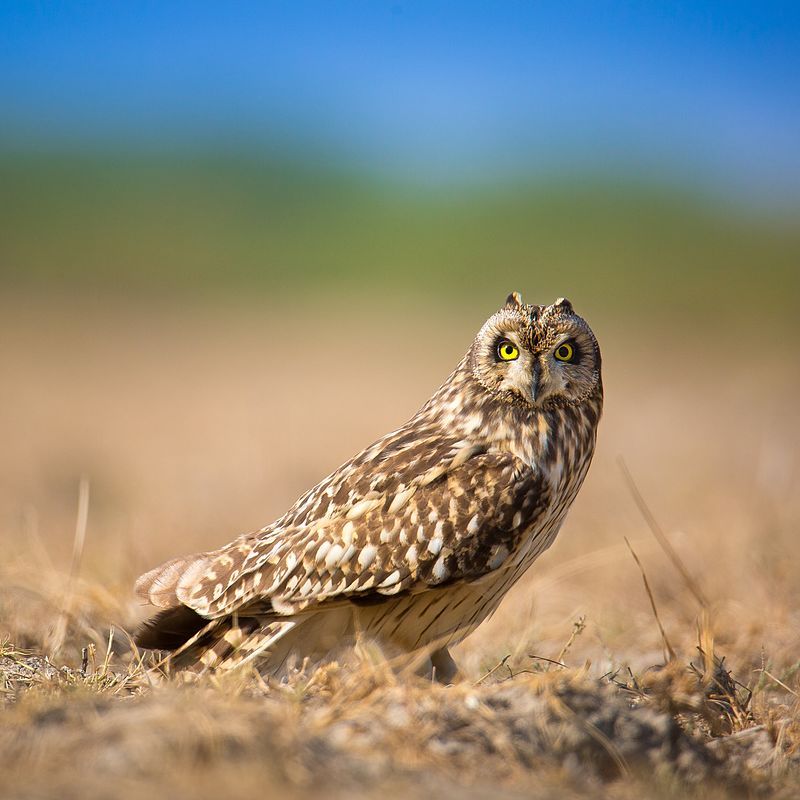
The Short-eared Owl, Asio flammeus, is a charismatic owl species known for its distinctive facial disk and short “ear” tufts. These owls have a mottled brown appearance and are often seen hunting during the day, unlike most owl species.
They primarily prey on small mammals, birds, and insects in open habitats like grasslands and marshes. Short-eared Owls are known for their communal roosting and hunting behavior, forming loose colonies during the winter months.
Their presence in wetlands highlights the importance of these habitats for breeding and wintering. With their diurnal habits and communal roosting, short-eared Owls offer a unique perspective on owl behavior within the avian world.
| Kingdom | Animalia |
| Phylum | Chordata |
| Clade | Dinosauria |
| Class | Aves |
| Order | Strigiformes |
| Family | Strigidae |
| Genus | Asio |
| Species | A. flammeus |
22. Snowy Owl (Bubo scandiacus)
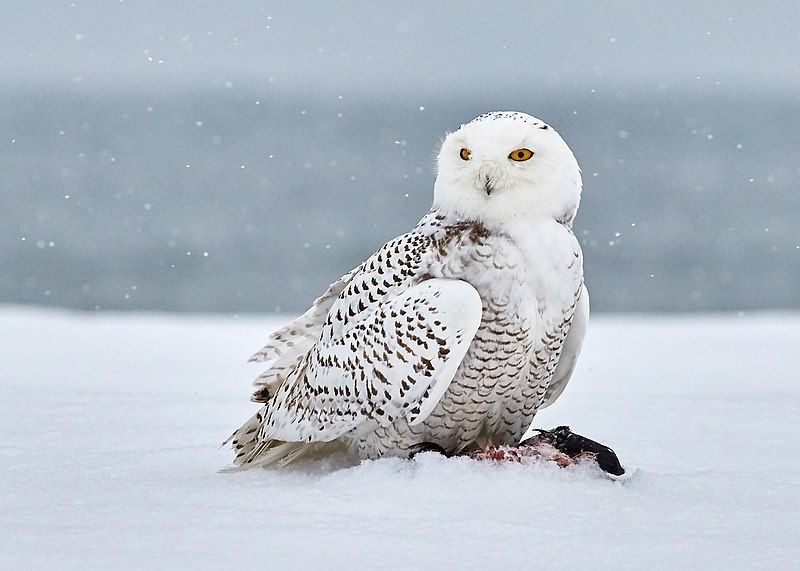
| Kingdom | Animalia |
| Phylum | Chordata |
| Clade | Dinosauria |
| Class | Aves |
| Order | Strigiformes |
| Family | Strigidae |
| Genus | Bubo |
| Species | B. scandiacus |
Conclusion
Indiana’s diverse habitats, from woodlands and wetlands to grasslands and urban areas, provide a welcoming home to a remarkable array of 22 birds of prey.
These raptors, with their diverse hunting techniques and specialized adaptations, are awe-inspiring to observe and vital for maintaining the ecological balance of the Hoosier State.
Their presence signifies the health of Indiana’s ecosystems and underscores the importance of preserving these natural environments.
Each species contributes to Indiana’s rich tapestry of wildlife, from the majestic Bald Eagle soaring over lakes to the stealthy Eastern screech owl hiding in suburban tree cavities.
These birds of prey serve as ambassadors for conservation and remind us of the need to protect the habitats they call home.